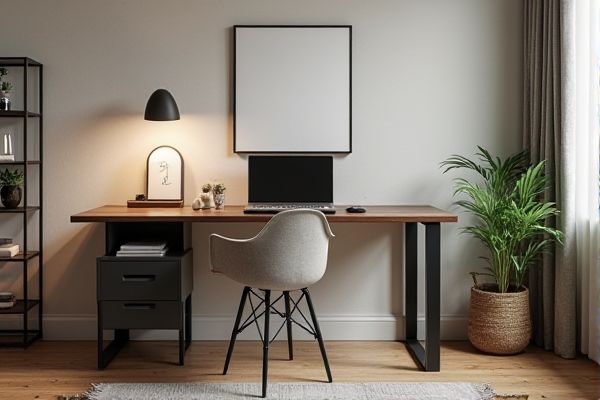
Wood desks offer a warm, classic aesthetic and sturdy construction that complements traditional office decor, while metal desks provide a modern, industrial look with superior durability and resistance to wear. Discover which desk suits Your workspace needs best by exploring the detailed comparison in the rest of this article.
Table of Comparison
| Feature | Wood Desk | Metal Desk |
|---|---|---|
| Material | Solid wood, plywood, or MDF | Steel, aluminum, or iron |
| Durability | Moderate to high; prone to scratches and dents | High; resistant to impact and wear |
| Weight | Heavy, depends on wood type | Generally lighter than solid wood |
| Maintenance | Requires regular polishing and cleaning | Low maintenance; easy to clean |
| Appearance | Warm, natural, classic look | Modern, sleek, industrial design |
| Cost | Moderate to high, depending on wood type | Low to moderate |
| Environmental Impact | Renewable if sourced sustainably | Recyclable metal but energy-intensive production |
| Customizability | High; can be carved, stained, and painted | Moderate; limited shaping and finishing |
Introduction to Wood and Metal Desks
Wood desks offer a classic, warm aesthetic with natural grain patterns that enhance any workspace, providing durability and ease of customization. Metal desks deliver superior robustness and a modern industrial look, ideal for heavy use environments requiring long-lasting support. Choosing the right desk depends on your needs for style, maintenance, and functionality in your work area.
Aesthetic Appeal: Wood vs Metal Desks
Wood desks offer a warm, natural aesthetic with rich grain patterns and varying tones, making them ideal for creating a cozy, traditional, or rustic workspace. Metal desks present a sleek, modern look with clean lines and industrial appeal, perfect for minimalist or contemporary office designs. Your choice between wood and metal desks depends on whether you prioritize timeless elegance or streamlined, high-tech aesthetics for your workspace.
Durability and Longevity Comparison
Wood desks offer excellent durability with solid hardwood varieties like oak and maple resisting scratches and dents over time, making them ideal for long-term use. Metal desks excel in longevity due to their resistance to warping, moisture, and pest damage, often lasting decades with minimal maintenance. Choosing between wood and metal desks depends on the environment and usage, as wood provides aesthetic warmth while metal delivers superior endurance in industrial or high-traffic settings.
Cost Differences: Wood Desk vs Metal Desk
Wood desks typically cost more upfront due to the expense of hardwood materials and craftsmanship, with prices ranging from $200 to $800 for quality options. Metal desks generally offer a more budget-friendly choice, often priced between $100 and $400, benefiting from mass production and durable steel components. Maintenance costs favor metal desks as they resist scratches and dents better, reducing the need for repairs compared to wood desks that may require refinishing or repairs over time.
Maintenance Requirements
Wood desks require regular maintenance such as polishing and protection from moisture to prevent warping and scratches, ensuring their longevity. Metal desks generally need less intensive upkeep, often only requiring occasional cleaning to remove dust and prevent rust, especially if they have a powder-coated finish. Choosing between wood and metal desks depends on your willingness to invest time in maintenance and the desired aesthetic durability.
Environmental Impact and Sustainability
Wood desks often have a lower environmental impact due to their renewable nature and biodegradability, especially when sourced from sustainably managed forests certified by organizations like FSC. Metal desks, while durable and recyclable, require energy-intensive mining and processing, leading to higher carbon emissions. Choosing your desk based on sustainable materials can significantly reduce your ecological footprint over time.
Comfort and Ergonomics
Wood desks offer a warm, tactile surface that supports comfort through natural material benefits, often featuring adjustable height options for ergonomic customization. Metal desks excel in durability and typically provide sleek, stable structures that promote posture alignment, though they may lack the softer touch of wood. Choosing your desk depends on balancing the tactile comfort of wood with the sturdy ergonomics of metal to optimize your workspace.
Customization and Design Options
Wood desks offer extensive customization and design options, allowing you to choose from various wood types, finishes, and carvings to create a unique and warm aesthetic. Metal desks provide sleek, modern designs with modular components that can be easily adjusted or reconfigured to fit specific workspace needs. Your choice depends on whether you prioritize organic textures and craftsmanship or industrial durability and flexibility.
Weight and Portability Factors
Wood desks are generally heavier and less portable due to the density and thickness of solid wood materials, making them more stable but harder to move. Metal desks often weigh less, benefiting from lightweight aluminum or steel frames that enhance portability and ease of relocation. Your choice will depend on whether you prioritize durability and stability (wood) or convenience and mobility (metal).
Ideal Use Cases: Choosing the Right Desk
Wood desks offer a warm, classic aesthetic ideal for home offices and creative workspaces, providing a sturdy surface for writing, computer work, and light storage. Metal desks excel in industrial or modern office settings, known for their durability, easy maintenance, and resistance to wear, making them perfect for heavy use and equipment-heavy tasks. Selecting between wood and metal desks depends on whether the priority is style and comfort or robustness and practicality for demanding environments.
 homyna.com
homyna.com